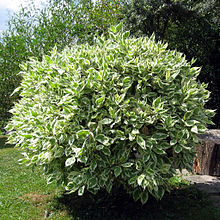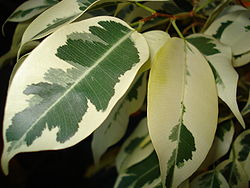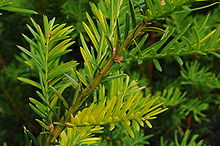- Chimera (plant)
-
Chimeras (or chimaeras) in botany are usually single organisms composed of two genetically different types of tissue. They occur in plants, on the same general basis as with animal chimeras. However, unlike animal chimeras, both types of tissues may have originated from the same zygote, and the difference is often due to mutation during ordinary cell division.
Contents
Derivation
The word chimera in these senses is a reference to the monstrous chimera of ancient Greek mythology, a legendary beast made up of parts of several different animals.
Types of plant chimera
The term “chimera” is applied to plant genetic mosaics where mosaicism is persistent and cells with two or more different genotypes coexist in a meristem. However, when describing mosaics in which cells with different genotypes are distributed all around the plant, the term can also be used.[1] Chimeras form a large and heterogenous group of plants, and it is convenient to classify these in three different ways.[2][3]
According to their origin
There are often authentic accounts of the origin of chimeras by spontaneous or induced mutations, by the sorting-out from variegated seedlings after plastid mutation, by grafting, by the layering of mixed populations of cells within callus tissue cultures, and by somatic hybridization through protoplast fusion.
According to their structure
The distinction between sectorial, mericlinal and periclinal chimeras are widely used.[4][5]
According to their behavior
A distinction can be made between four kinds of chimeras owing to the magnitude of the differences between them and what might be expected from their behavior:
Species of graft chimeras
These are produced by grafting together different species or genera, which involve tissues from two genetically different parents, different cultivars or different species (which may belong to different genera). The tissues may be partially fused together following grafting to form a single growing organism that preserves both types of tissue in a single shoot.[6] Just as the constituent species are likely to differ in a wide range of features, so the behavior of their periclinal chimeras is like to be highly variable.[7] The first such known chimera was probably the Bizzaria which is a confusion of the Florentine citron and the sour orange. Perhaps the best-known example of a graft-chimera is Laburnocytisus 'Adamii', caused by a fusion of a Laburnum and a broom.
Chromosomal chimeras
These are chimeras in which the layers differ in their chromosome constitution. Occasionally chimeras arise from loss or gain of individual chromosomes or chromosome fragments owing to misdivision.[8] More commonly cytochimeras have simple multiple of the normal chromosome complement in the changed layer. There are various effects on cell size and growth characteristics.
Nuclear gene-differential chimeras
These chimeras arise by spontaneous or induced mutation of a nuclear gene to a dominant or recessive allele. As a rule one character is affected at a time in the leaf, flower, fruit, or other parts.
Plastid gene-differential chimeras
These chimeras arise by spontaneous or induced mutation of a plastid gene, followed by the sorting-out of two kinds of plastid during vegetative growth. Alternatively, after selfing or nucleic acid thermodynamics, plastids may sort-out from a mixed egg or mixed zygote respectively. This type of chimera is recognized at the time of origin by the sorting-out pattern in the leaves. After sorting-out is complete, periclinal chimeras are distinguished from similar looking nuclear gene-differential chimeras by their non-mendelian inheritance. The majority of variegated-leaf chimeras are of this kind.
All plastid gene- and some nuclear gene-differential chimeras affect the color of the plasmids within the leaves, and these are grouped together as chlorophyll chimeras, or preferably as variegated leaf chimeras. For most variegation, the mutation involved is the loss of the chloroplasts in the mutated tissue, so that part of the plant tissue has no green pigment and no photosynthetic ability. This mutated tissue is unable to survive on its own but is kept alive by its partnership with normal photosynthetic tissue. Sometimes chimeras are also found with layers differing in respect of both their nuclear and their plastid genes.
Propagation
Because chimeras have more than one type of genetic material, while they may produce viable offspring from seed, these will not be true to type. All propagation that preserves the variation has to be by cuttings or division. Some types of cuttings, such as root cuttings, will produce entirely new growing points, usually from the inner one of the two types of tissue, so that these cannot be used either.
Chimeras in plant transformation
Genetic engineering is widely used to alter the traits of certain plants. Generally speaking, it involves recombinant DNA integration, either through traditional or non-traditional way, and transgenic plant recovery. Agrobacterium mediated transformation involves callus generation, co-cultivation with agrobacterium and later on followed by plant regeneration. Tissued transformed with exogenous genes could contain both transformed cells and non-transformed cells. In many plant transformation systems, a selection marker such as the herbicide or antibiotics resistance genes is utilized to distinguish the transformed ones with untransformed ones. Even so there is still high chance that transgenic plant became a chimera.
Reasons
There are multiple reasons to explain the occurrence of plant chimera during plant recovery stage. (1)The process of shoot organogenesis starts form the multicellular origin.[9] (2)The endogenous tolerance leads to the ineffectiveness of the weak selective agents. (3)A self-protection mechanisim (cross protection). Transformed cells serve as guards to protect the untransformed ones.[10] (4)The observable characteristic of transgenic cells may be a transient expression of the marker gene. Or it may due to the presence of agrobacterium cells.
Detection
Untransformed cells should be easy to detect and remove to avoid chimeras. Because it’s extremely important to maintain the stable ability of the transgenic plants across different generations. Reporter genes such as GUS and Green Fluorescent Protein[11](GFP) are utilized in combination with plant selective markers (herbicide, antibody etc.) However, GUS expression depends on the plant development stage and GFP may be influenced by the green tissue autofluorescence. QRT-PCR could be an alternative method for chimera detection.[12]
See also
References
- ^ Poethig RS. (1987). "Clonal analysis of cell lineage patterns in plant development". Am. J. Bot. 74 (4): 581–594. doi:10.2307/2443838.
- ^ Tileny-Bassett, R.A.E. (1963). "The structure of periclinal chimeras.". Heredity 18 (3): 265–285. doi:10.1038/hdy.1963.30.
- ^ A glossary of genetics and cytogenetics: classical and molecular, 3rd edition,1968, George Allen and Unwin, London, ISBN 3540043160
- ^ The plastids: their chemistry, structure, growth and inheritance, 2nd edition,1978, Elsevier/ North-Holland, Amsterdam, ISBN 0444800220
- ^ Mutation breeding techniques and behavior of irradiated shoot apices of potato, 1978, Pudoc, Wageingen
- ^ Norris, R., Smith, R.H., and Vaughn, K.C. (1983). "Plant chimeras used to establish de novo origin of shoots". Science 220 (4592): 75–76. doi:10.1126/science.220.4592.75.
- ^ Plant Chimeras, 1st edition, 1992, Cambridge University Press, ISBN 0521427878
- ^ Thompson, J.D., Herre, E.A., Hamrick, J.L., and Stone, J.L. (1991). "Genetic mosaics in strangler fig trees: implication for tropical conservation". Science 254 (5035): 1214–1216. doi:10.1126/science.254.5035.1214. PMID 17776412.
- ^ Zhu, X., Zhao, M., Ma, S., Ge, Y., Zhang, M., and Chen, L. (2007). "Induction and origin of adventitious shoots from chimeras of Brassica juncea and Brassica oleracea". Plant Cell Rep 26 (10): 1727–1732. doi:10.1007/s00299-007-0398-4.
- ^ Park SH, Rose SC, Zapata C, Srivatanakul M. (1998). "Cross-protection and selectable marker genes in plant transformation.". In Vitro Cellular & Developmental Biology - Plant 34 (2): 117–121. doi:10.1007/BF02822775.
- ^ Rakosy-Tican, E., Aurori, C.M., Dijkstra, C., Thieme, R., Aurori, A., and Davey, M.R. (2007). "The usefulness of the gfp reporter gene for monitoring Agrobacterium-mediated transformation of potato dihaploid and tetraploid genotypes". Plant Cell Rep 26 (5): 661–671. doi:10.1007/s00299-006-0273-8.
- ^ Faize, M., Faize, L. and Burgos, L. (2010). "Using quantitative real-time PCR to detect chimeras in transgenic tobacco and apricot and to monitor their dissociation". BMC Biotechnology 10 (1): 53. doi:10.1186/1472-6750-10-53.
External links
Categories:
Wikimedia Foundation. 2010.




